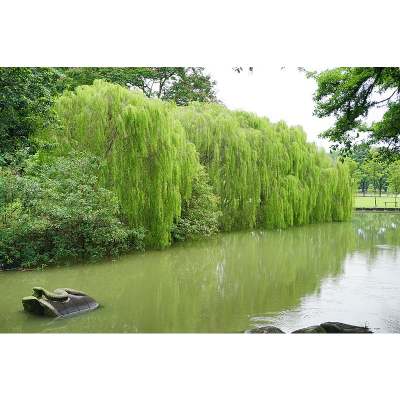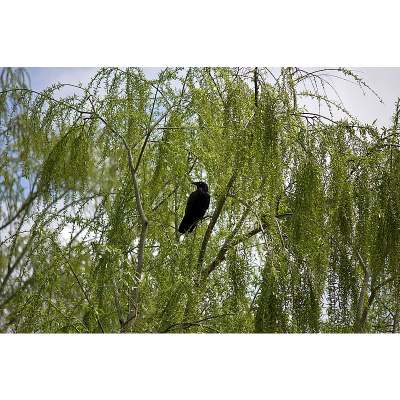The Australian Willow tree is a versatile species with various advantages, including providing ample shade, fast growth, and erosion control. It also offers aesthetic appeal, wildlife habitat, and low maintenance. However, it comes with disadvantages such as invasive tendencies, high water consumption, and weak wood structure.
| Pros | Cons |
|---|---|
| Provides ample shade | Invasive species |
| Aesthetic appeal | High water consumption |
| Fast growth | Weak wood structure |
| Erosion control | Allergenic pollen |
| Wildlife habitat | Maintenance challenges |
| Low maintenance | Root system issues |
| Drought tolerance | |
| Windbreak | |
| Timber production | |
| Soil improvement |
Pro: Shade Provider
Australian Willow trees are renowned for their exceptional shade-providing capabilities. With their broad, willow-shaped leaves and a dense canopy, they create a cool oasis on even the hottest Australian days. These trees can significantly reduce the temperature in your outdoor space, making them ideal for relaxing under on a scorching summer day.
Moreover, the shade they provide is not only pleasant for humans but also beneficial for various plants that thrive in the cooler environment created by these trees. The canopy filters sunlight, providing indirect, gentle light for the plants beneath, fostering their growth.
Also Read :
Should I Plant a Weeping Willow? – A Gardener’s Guide
Weeping Willow Tree Texas – Size, Sale and Growing Tips
Willow Tree Spiritual Meaning : What is The Symbol Represents?
How Fast Does A Weeping Willow Grow? Growth Rate (Salix chrysocoma)
Black Willow Vs Weeping Willow: The Ultimate Showdown of Graceful Trees
Weeping Willow Tree Pros and Cons : 10 Points Explained
Pro: Aesthetic Appeal
One of the standout features of Australian Willow trees is their striking aesthetic appeal. The drooping branches and gracefully swaying leaves give these trees a unique and attractive appearance. Whether in urban settings, parks, or private gardens, they add a touch of elegance and natural beauty.
The long, slender leaves rustle in the wind, creating a soothing, melodic sound. This makes Australian Willow trees not only a visual delight but also an auditory one, enhancing the overall atmosphere of your outdoor space.

Pro: Fast Growth
If you’re looking for rapid tree growth, Australian Willow trees are an excellent choice. These trees are known for their vigor and can add significant height to your landscape in a relatively short period. In just a few years, you can have a substantial, mature tree providing shade and enhancing the aesthetics of your surroundings.
Their fast growth rate makes them a popular choice for individuals who want a quick transformation of their outdoor spaces or those who are impatient to enjoy the benefits of a shaded area.
Pro: Erosion Control

In regions prone to erosion, Australian Willow trees offer a natural solution. Their extensive root systems help bind the soil together, preventing it from washing away during heavy rains. This can be particularly useful in hilly or coastal areas where erosion is a constant concern.
The combination of the tree’s deep roots and its dense canopy works together to stabilize the soil, making it an effective and eco-friendly means of erosion control.
Pro: Wildlife Habitat
Australian Willow trees provide more than just shelter for humans; they also serve as valuable habitat for wildlife. The branches and leaves offer refuge and nesting sites for various bird species. Their dense canopy provides a safe haven for these birds to raise their young.
Additionally, the tree’s flowers and seeds attract pollinators and other insects, further enhancing the local ecosystem. In this way, Australian Willow trees contribute to the overall biodiversity of their surroundings.
Pro: Low Maintenance
For those seeking a low-maintenance tree for their landscape, the Australian Willow is an excellent choice. Once established, these trees require minimal care. They can tolerate a range of soil types and thrive in diverse environmental conditions.
Their resilience and adaptability make them ideal for homeowners who prefer a hands-off approach to gardening but still want the benefits of having trees in their yard.
Pro: Drought Tolerance
In the often arid Australian climate, drought tolerance is a valuable trait in a tree. Australian Willow trees can thrive with minimal water, making them an asset in regions where water resources are limited or during dry spells.
Their ability to endure extended periods of drought without significant harm to their health makes them a resilient and sustainable choice for landscaping.
Pro: Windbreak
The sturdy, drooping branches of Australian Willow trees are excellent for windbreak purposes. Planted in rows, they can create an effective barrier against strong winds that might damage structures or gardens. This quality makes them popular in coastal areas where they shield against salt-laden sea breezes.
The dense foliage also helps reduce wind velocity, creating a more comfortable microclimate around the tree, making it a preferred choice for outdoor gatherings and relaxation.
Pro: Timber Production
Although not as famous as other timber-producing trees, Australian Willow wood is a valuable resource. The timber is used for various purposes, including making furniture, cabinets, and flooring. It has a smooth, attractive grain pattern, making it desirable for woodworking projects.
The ability to harvest timber from these trees, in addition to their other benefits, makes them a multifunctional addition to any property.
Pro: Soil Improvement
The deep root system of Australian Willow trees has a positive impact on soil quality. The roots help break up compacted soil, allowing for better water infiltration and aeration. This can be especially useful in areas with clayey or poorly drained soil.
Additionally, the leaves of these trees contribute to the improvement of soil fertility as they decompose, adding organic matter to the ground. This enhances the overall health of your garden and promotes the growth of other plants.
Con: Invasive Species
Despite their many advantages, Australian Willow trees are not without their drawbacks. One significant concern is their invasive nature. These trees have the propensity to spread rapidly and aggressively, displacing native vegetation and altering local ecosystems.
In areas where they become invasive, Australian Willow trees can threaten the survival of native plants and wildlife. Thus, it’s essential to carefully consider their planting and potential impact on the local environment.
Con: Water Consumption
One of the main downsides of Australian Willow trees is their high water consumption. They demand a significant amount of water to sustain their rapid growth and dense canopy. In regions with limited water resources or where drought is a frequent occurrence, the water needs of these trees can be a significant drawback.
Their thirst for water makes them less suitable for areas where water conservation is a top priority.
Con: Weak Wood Structure
The wood of Australian Willow trees, while useful for various purposes, has a reputation for being somewhat weak. The branches are prone to breakage, especially during storms or strong winds. This can pose a risk to property and individuals, making them less desirable in locations where tree damage is a concern.
Regular pruning and maintenance may help mitigate this issue, but it remains a point of consideration.
Con: Allergenic Pollen
Another drawback of Australian Willow trees is their production of allergenic pollen. This can be problematic for individuals with allergies or respiratory sensitivities. The airborne pollen from these trees can trigger allergic reactions, leading to discomfort and health issues for those affected.
Before planting Australian Willow trees, it’s crucial to be mindful of the potential impact on the health of people in the vicinity.
Con: Maintenance Challenges
While Australian Willow trees are low-maintenance once established, they can present challenges during their initial growth stages. Their rapid development requires regular pruning and shaping to maintain the desired appearance and prevent overgrowth.
Furthermore, their invasive tendencies mean that vigilant monitoring and management are essential to prevent them from spreading uncontrollably.
Con: Root System Issues
The extensive root system of Australian Willow trees, while beneficial for soil improvement, can also be problematic. These roots have been known to invade water pipes, drainage systems, and the foundations of buildings, leading to structural damage and costly repairs.
Proper planning and care are necessary to avoid root-related issues and potential damage to infrastructure.
In conclusion, Australian Willow trees offer a range of benefits, including providing ample shade, fast growth, and erosion control. They add aesthetic appeal to landscapes, create wildlife habitats, and require low maintenance. These trees are drought-tolerant, act as windbreaks, produce
timber, and improve soil quality. However, they come with their share of drawbacks, such as being invasive species, having high water consumption, and having a weak wood structure. They also produce allergenic pollen, pose maintenance challenges, and can cause issues with their extensive root systems.
It’s essential to carefully weigh the pros and cons of Australian Willow trees before deciding to plant them in your landscape. Consider your specific needs, the local environment, and the potential long-term consequences of introducing these trees. Here are some key points to keep in mind when making your decision:
Pros to Consider:
- Shade Provider: Australian Willow trees offer excellent shade, making them ideal for creating a cool and comfortable outdoor environment.
- Aesthetic Appeal: Their unique appearance and rustling leaves add a touch of natural beauty and tranquility to your surroundings.
- Fast Growth: If you desire quick results in your landscaping, Australian Willow trees can provide rapid growth and transformation.
- Erosion Control: They help prevent soil erosion in areas prone to this issue, promoting soil stability and health.
- Wildlife Habitat: These trees support local wildlife by providing shelter and attracting beneficial insects.
- Low Maintenance: Once established, Australian Willow trees require minimal care, making them suitable for those seeking an easy-to-maintain option.
- Drought Tolerance: In water-scarce regions, their ability to withstand drought is a valuable asset.
- Windbreak: They create effective windbreaks and microclimates, making outdoor spaces more comfortable.
- Timber Production: The wood from these trees is useful for various woodworking projects.
- Soil Improvement: Australian Willow trees enhance soil quality through their deep roots and decomposing leaves.
Cons to Be Aware Of:
- Invasive Species: Their invasive nature can disrupt local ecosystems, threatening native plants and wildlife.
- Water Consumption: These trees have high water demands, which can be problematic in regions with limited water resources.
- Weak Wood Structure: The branches are prone to breakage, potentially causing property damage and safety concerns.
- Allergenic Pollen: The production of allergenic pollen can affect individuals with allergies or respiratory sensitivities.
- Maintenance Challenges: During their initial growth stages, Australian Willow trees require regular pruning and management to prevent overgrowth.
- Root System Issues: Their extensive root system can invade infrastructure, leading to structural damage and costly repairs.
In summary, Australian Willow trees can be a valuable addition to your landscape, but their advantages and disadvantages must be carefully considered. If you decide to plant these trees, be prepared to manage them effectively, monitor their growth, and take measures to prevent their invasive tendencies from causing harm to the local environment. By doing so, you can enjoy the many benefits these trees offer while minimizing their drawbacks.
